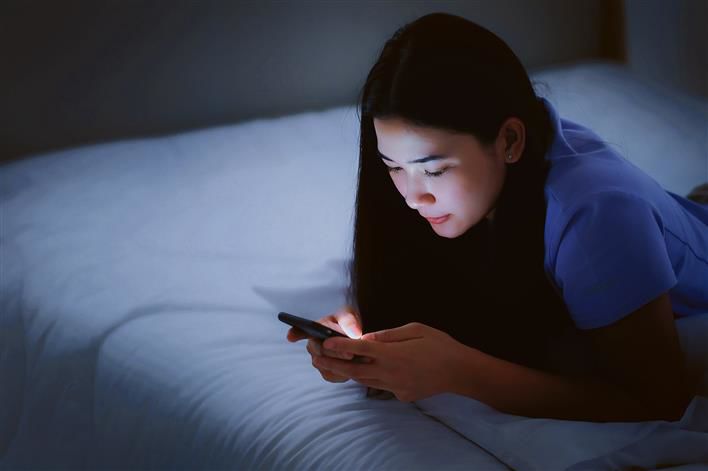
Vikas Sharma
AN IT professional recently came seeking treatment for brownish to greyish pigmented spots on her cheeks, nose and forehead, besides thinning of eyebrows, under-eye puffiness and wrinkles around the eyes. These problems had developed in the past six months after the youngster started working in the IT sector. She did not suffer from any medical problems and her blood tests were normal.
Due to long working hours, she had been spending 11 to 12 hours daily in front of her laptop or mobile. She is not alone as the incidence and prevalence of such cases have increased in the last few years. Most dermatology OPDs are seeing at least 15 to 20 patients with similar symptoms every day.
In our artificially-lit modern lives, the skin is being constantly subjected to blue light due to the increased use of electronic equipment, smartphones and laptops. Blue light exposure not only affects sleep cycles and causes dry-eye syndrome, but also compromises skin health. This exposure accelerates the ageing process and produces hyperpigmentation of the skin.
Depending on the source, the spectrum of this blue light ranges from 420 to 490 nm wavelength and can penetrate the skin more deeply than UVA and UVB rays from the sun. It extends past the outer surface of the skin deep into its underlying layers, damaging the collagen and elastin fibres, and results in loss of firmness of skin and causes early age spots.
This causes skin changes like brownish and greyish pigmentation on face, under the eyes, on cheeks, nose and forehead. Swelling in the skin around the eyes, early wrinkles and redness as well as puffiness, lines and wrinkles under the eyes, deepening of skin creases from nose to the corners of mouth and sagging of lower jowls can also be signs of blue light damage. Many young patients who are constantly over-exposed to blue light also experience thinning of eyebrows and eyelashes, premature greying of hair and deepening of skin lines on the neck.
Research shows that exposure of skin cells to blue light emitted from electronic devices can lead to changes in skin cells, cell division and secretion patterns, including cell shrinkage and death of cells. These speed up the ageing process. Even exposures as short as 60 minutes can trigger these changes.
Blue light can also cause inflammation in the skin, leading to redness, sensitivity, and irritation. This inflammation can flare up skin conditions such as acne, rosacea, eczema and lupus. If patients with lupus, rosacea and photo-sensitive eczema use screens for a long time, they can develop rashes on their face, despite avoiding sun and remaining indoors.
As compared to pigmentation induced by sun’s UV radiation, blue light-induced pigmentation tends to be darker, more sustained and more resistant to treatments. This has more pronounced implications for our Indian skin that’s normally brown, burns minimally and tans easily.
Preventive measures
Protecting skin from blue light damage is important for maintaining skin health. Some of these preventive steps can help.
Take breaks: Limit exposure by taking frequent breaks from screens. Follow the 20-20-20 rule — every 20 minutes, take a 20-second break and look at something 20 feet away.
Use blue light filters on screens: Blue light filters/blocking glasses and laptop shields can help reduce the exposure.
Use protective sunscreens or barrier creams: Sunscreens or creams containing iron oxide, zinc oxide, titanium dioxide can protect the skin against UVA and UVB rays and blue light damage. Apply frequently.
Eat a healthy diet: A diet rich in antioxidants can help neutralise free radicals and reduce the damage of blue light on the skin and hair. Have more fruits and vegetables, nuts, whole grains and green tea.
Skincare products and serums: Products and serums containing vitamins C, E and ferulic acid protect skin from damage by free radicals. But early diagnosis remains the best prevention.
How the damage happens
Blue light exposure can lead to an increase in the production of free radicals in the skin. Free radicals then attack the healthy skin cells, causing skin damage. Blue light can penetrate the deeper layers of skin, thus damaging collagen and elastin, two proteins responsible for giving strength, firmness, youthfulness and flexibility to skin. This damage accelerates ageing (also known as photo-ageing) because skin loses its plump, voluminous integrity and becomes more prone to the development of fine lines and wrinkles. The free radicals created by excess blue light also impair the functionality of the skin-cell barrier, leading to loss of moisture retention and weakened immunity.
—The writer is a dermatologist, National Skin Hospital, Panchkula
Join Whatsapp Channel of The Tribune for latest updates.



























